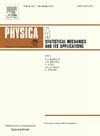模拟复杂网络扰动对双边区域贸易协定复原力的影响
IF 2.8
3区 物理与天体物理
Q2 PHYSICS, MULTIDISCIPLINARY
Physica A: Statistical Mechanics and its Applications
Pub Date : 2024-10-18
DOI:10.1016/j.physa.2024.130168
引用次数: 0
摘要
当受到外部冲击或内部干扰时,贸易协定网络内合作关系的复原力凸显了网络结构在贸易协定体系的稳健性和适应性中的作用。为了弥补在理解贸易协定网络动态复原力方面的空白,本研究构建了一个基于双边区域贸易协定的复杂网络。通过运用互惠动力学来衡量网络中各国之间的合作关系,我们模拟了复杂网络扰动对双边区域贸易协定弹性的影响。我们考虑了各种复杂的网络扰动,包括节点移除、链接移除以及网络重新洗牌的三阶空模型,分别对应贸易协定失效、协定同时失效和签署。实验结果表明,随着节点和链接的随机移除,网络弹性逐渐减弱。然而,当根据节点的度数移除节点时,事实证明先移除度数较大的节点比相反的移除节点更有效。具体来说,当移除较小的节点时,网络复原力下降得更快。这凸显了拥有众多贸易协定的国家对整体网络弹性的重要贡献。在网络洗牌实验中,洗牌顺序的增加与网络恢复力的逐步下降相关,并最终向实际值靠拢。这些发现强调了网络结构在维持贸易协定体系的稳定性和适应性方面的重要性。本文章由计算机程序翻译,如有差异,请以英文原文为准。
Modeling complex network perturbations on resilience of the bilateral regional trade agreements
The resilience of cooperative relationships within a trade agreement network, when subjected to external shocks or internal disturbances, underscores the role of network structure in the robustness and adaptability of the trade agreement system. Addressing the gap in understanding the resilience of trade agreement network dynamics, this study constructs a complex network based on the bilateral regional trade agreements. By applying reciprocal dynamics to measure cooperative relationships among countries in the network, we model the impact of complex network perturbations on the resilience of bilateral regional trade agreements. Various complex network perturbations are considered, including node removal, link removal, and three orders of null models for network reshuffling, which correspond to the failure of a trade agreement, simultaneous agreement failure, and signing. Experimental findings reveal that network resilience gradually diminishes with the random removal of nodes and links. However, when nodes are removed based on their degree, removing nodes with larger degrees first proves to be more effective than the reverse. Specifically, network resilience decreases more rapidly when smaller nodes are removed. This highlights the significant contribution of countries with numerous trade agreements to the overall network resilience. In network reshuffling experiments, an increase in the order of reshuffling correlates with a gradual decrease in network resilience, ultimately converging toward real values. These findings emphasize the importance of network structure in maintaining the stability and adaptability of trade agreement systems.
求助全文
通过发布文献求助,成功后即可免费获取论文全文。
去求助
来源期刊
CiteScore
7.20
自引率
9.10%
发文量
852
审稿时长
6.6 months
期刊介绍:
Physica A: Statistical Mechanics and its Applications
Recognized by the European Physical Society
Physica A publishes research in the field of statistical mechanics and its applications.
Statistical mechanics sets out to explain the behaviour of macroscopic systems by studying the statistical properties of their microscopic constituents.
Applications of the techniques of statistical mechanics are widespread, and include: applications to physical systems such as solids, liquids and gases; applications to chemical and biological systems (colloids, interfaces, complex fluids, polymers and biopolymers, cell physics); and other interdisciplinary applications to for instance biological, economical and sociological systems.

 求助内容:
求助内容: 应助结果提醒方式:
应助结果提醒方式:


